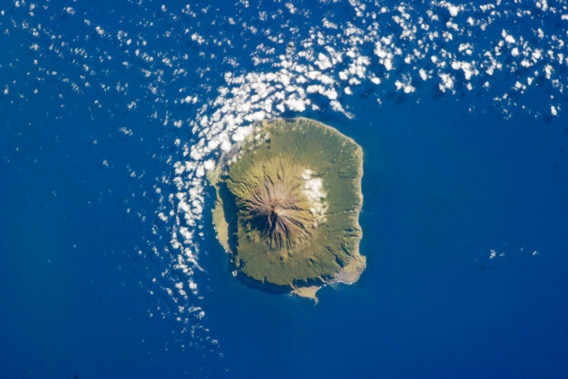Create a free profile to get unlimited access to exclusive videos, sweepstakes, and more!
OK, Here’s a (Mostly) Circular Volcano For Real

Last weekend, I posted a picture of a volcano that had fooled me into thinking the flanks were a nearly perfect circle. Actually, New Zealand declared a circular area around the peak as a national park, so the border between the park and farmland outside itâa literally unnatural circleâis obvious, even from space.
So, mea culpa. To make up for my mistake, hereâs another volcano seen from space, and barring a few blemishes (which themselves are awesome) it really is highly circular. Or at least it's trying to be.
That is the Tristan da Cunha island in the southern Atlantic, as seen by an astronaut on the International Space Station. Itâs a shield volcano, a broad cone built up by what are called effusive eruptions; lava pouring out from the main vent or from the flanks. The lava from Tristan da Cunha has low viscosityâitâs relatively thinâso it can flow long distances, building up the slope of the cone. The island volcano is about 13 kilometers (8 miles) across.
Both the geology and the geography of the island are fascinating. In the case of the latter, it has what is considered the most remote settlement in the world: Edinburgh of the Seven Seas, which has a population of fewer than 300 people. The nearest inhabited land is over 2800 kilometers (1750 miles) away!
The volcano is part of a small chain that has a similar formation mechanism to the Hawaiian and Canary islands; the current idea is that there is a hotspot under the crust created by a rising plume of mantle material. As the crust moves due to continental drift, the plume creates an island chain of volcanoes. Tristan da Cunha is the largest of the islands in the chain. The peak rises over 2000 meters (1.3 miles) above the sea.
The circular nature of the flank here is not a surprise; the fluid lava flows from the main vent would, on average, spread in all directions. Whatâs more interesting, perhaps, are where the symmetry is broken. There are dramatic cliffs at various spots, some 600 meters (2000 feet) high, including the amazing one to the northwest (left) in the picture from space. This is where the rock from the flank has cracked and dropped into the ocean, leaving behind those tall, steep cliffs. The northwest cliffs have a large bench, a flat area, along the coast. That must be an unbelievable sight, to stand there and soak in this magnificent view.
Iâd love to visit this place someday, but it's so remote that realistically I doubt that will happen. There are so many wonderful sites to see on this planet! For now, Iâll just have to be happy with this view from a few hundred kilometers above it.


























